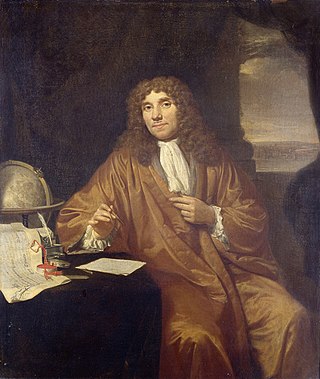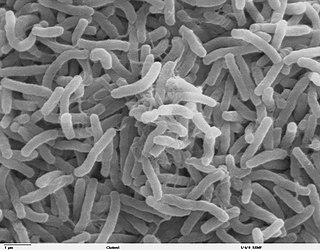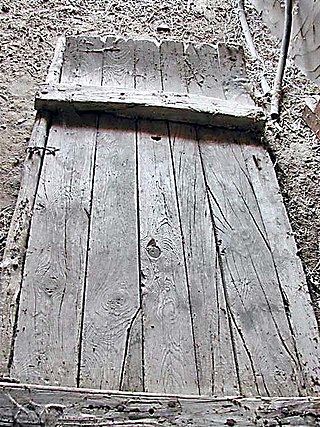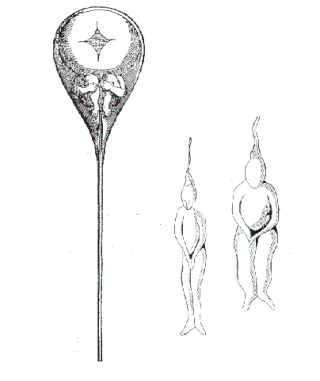
A microorganism, or microbe, is an organism of microscopic size, which may exist in its single-celled form or as a colony of cells.

Antonie Philips van Leeuwenhoek was a Dutch microbiologist and microscopist in the Golden Age of Dutch science and technology. A largely self-taught man in science, he is commonly known as "the Father of Microbiology", and one of the first microscopists and microbiologists. Van Leeuwenhoek is best known for his pioneering work in microscopy and for his contributions toward the establishment of microbiology as a scientific discipline.
This timeline of biology and organic chemistry captures significant events from before 1600 to the present.
An anaerobic organism or anaerobe is any organism that does not require molecular oxygen for growth. It may react negatively or even die if free oxygen is present. In contrast, an aerobic organism (aerobe) is an organism that requires an oxygenated environment. Anaerobes may be unicellular or multicellular. Most fungi are obligate aerobes, requiring oxygen to survive. However, some species, such as the Chytridiomycota that reside in the rumen of cattle, are obligate anaerobes; for these species, anaerobic respiration is used because oxygen will disrupt their metabolism or kill them. Deep waters of the ocean are a common anoxic environment.

In biology, cell theory is a scientific theory first formulated in the mid-nineteenth century, that organisms are made up of cells, that they are the basic structural/organizational unit of all organisms, and that all cells come from pre-existing cells. Cells are the basic unit of structure in all organisms and also the basic unit of reproduction.

The germ theory of disease is the currently accepted scientific theory for many diseases. It states that microorganisms known as pathogens or "germs" can affect disease. These small organisms, too small to be seen without magnification, invade humans, other animals, and other living hosts. Their growth and reproduction within their hosts can cause disease. "Germ" refers to not just a bacterium but to any type of microorganism, such as protists or fungi, or even non-living pathogens that can cause disease, such as viruses, prions, or viroids. Diseases caused by pathogens are called infectious diseases. Even when a pathogen is the principal cause of a disease, environmental and hereditary factors often influence the severity of the disease, and whether a potential host individual becomes infected when exposed to the pathogen. Pathogens are disease-carrying agents that can pass from one individual to another, both in humans and animals. Infectious diseases are caused by biological agents such as pathogenic microorganisms as well as parasites.
Marcus Terentius Varro was a Roman polymath and a prolific author. He is regarded as ancient Rome's greatest scholar, and was described by Petrarch as "the third great light of Rome". He is sometimes called Varro Reatinus to distinguish him from his younger contemporary Varro Atacinus.
The microscopic scale is the scale of objects and events smaller than those that can easily be seen by the naked eye, requiring a lens or microscope to see them clearly. In physics, the microscopic scale is sometimes regarded as the scale between the macroscopic scale and the quantum scale. Microscopic units and measurements are used to classify and describe very small objects. One common microscopic length scale unit is the micrometre, which is one millionth of a metre.
Geoponici, or Scriptores rei rusticae, is a collective term for the Greek and Latin writers on husbandry and agriculture. In classical times it was regarded as a branch of economics.
Mago was a Carthaginian writer, author of an agricultural manual in Punic which was a record of the farming knowledge of Carthage, The Punic text has been lost, but some fragments of Greek and Latin translations survive.

A threshing board, also known as threshing sledge, is an obsolete agricultural implement used to separate cereals from their straw; that is, to thresh. It is a thick board, made with a variety of slats, with a shape between rectangular and trapezoidal, with the frontal part somewhat narrower and curved upward and whose bottom is covered with lithic flakes or razor-like metal blades.
Protistology is a scientific discipline devoted to the study of protists, a highly diverse group of eukaryotic organisms. All eukaryotes apart from animals, plants and fungi are considered protists. Its field of study therefore overlaps with the more traditional disciplines of phycology, mycology, and protozoology, just as protists embrace mostly unicellular organisms described as algae, some organisms regarded previously as primitive fungi, and protozoa.

In the history of biology, preformationism is a formerly popular theory that organisms develop from miniature versions of themselves. Instead of assembly from parts, preformationists believed that the form of living things exist, in real terms, prior to their development. It suggests that all organisms were created at the same time, and that succeeding generations grow from homunculi, or animalcules, that have existed since the beginning of creation, which is typically defined by religious beliefs.

Monera (/məˈnɪərə/) is historically a biological kingdom that is made up of prokaryotes. As such, it is composed of single-celled organisms that lack a nucleus. It has been superseded by the three-domain system.

Microbiology is the scientific study of microorganisms, those being of unicellular (single-celled), multicellular, or acellular. Microbiology encompasses numerous sub-disciplines including virology, bacteriology, protistology, mycology, immunology, and parasitology.
The gens Cossinia was a plebeian family at Rome. The gens originated at Tibur, and came to Rome early in the first century BC. None of its members ever obtained the higher offices of the state.

The gens Fundania was a plebeian family at Ancient Rome, which first appears in history in the second half of the third century BC. Although members of this gens occur well into imperial times, and Gaius Fundanius Fundulus obtained the consulship in BC 243, the Fundanii were never amongst the more important families of the Roman state.

Georg Goetz was a German classical philologist, known for his scholarly treatment of Plautus and Varro.
The gens Tremellia was a minor plebeian family at ancient Rome. Members of this gens are first mentioned towards the end of the Second Punic War, but the highest rank ever attained by any of the Tremellii under the Republic was that of praetor. After falling into obscurity during the first century BC, the fortunes of this family briefly revived under the Empire, when Gnaeus Tremellius was appointed consul suffectus in AD 21, during the reign of Tiberius.
Quintus Fulvius Lippinus, Fulvius Lippinus for short was an enterprising Roman farmer from the first century BC. He lived in the Roman region of Tarquinia, today's Italian Tuscany. His dealings are described in the Rerum rusticarum libri III by Marcus Terentius Varro, and a century later in Pliny the Elder's Naturalis Historia.











